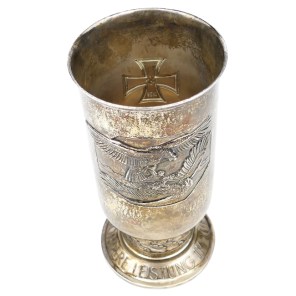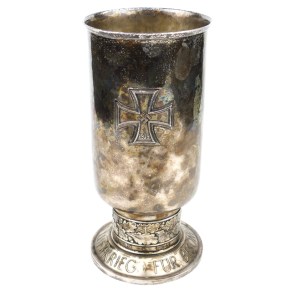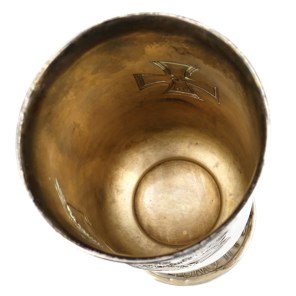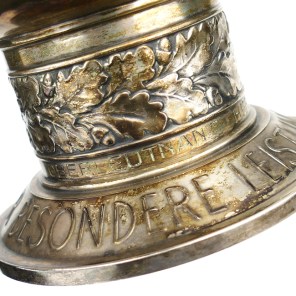Silver Luftwaffe Honor Goblet
Silver Luftwaffe Honor Goblet (Ehrenpokal der Luftwaffe). The "Ehrenpokal der Luftwaffe" was established on 27 February 1940 by Reichsmarschall Hermann Göring, the Reichs Minister of Aviation and Commander-in-Chief of the Luftwaffe. It was officially known as the Ehrenpokal "für Besondere Leistung im Luftkrieg" (Honor Goblet "For Special Achievement in the Air War"). The award was given to flying personnel (pilots and aircrew) only. Recipients names were published in the periodical 'Ehrenliste der Deutschen Luftwaffe' (Honor List of the German Air Force). German archives indicate that approximately 58,000 were given on paper, but only 13-15,000 goblets were actually awarded according to the records. The design of the goblot reflects that of the World War I goblet, the "Ehrenbecher für Sieger im Luftkampf". Superbly crafted by the firm of 'Joh. Wagner & Sohn' in Berlin which was the sole manufacturer ot this non-portable award. The goblet was awarded to aircrew members who had already been awarded the Iron Cross First Class but whose performance was not considered to merit the German Cross or Knight's Cross of the Iron Cross. This goblet was awarded on 1 January 1941 to Oberleutnant 'Hermann Schmitt', he was a member within the '1./Kampf-Geschwader 77'. The Kampfgeschwader 77 was mainly equipped with the Do 17Z. During the Polish campaign I. and III. Gruppe of KG 77 took part in combat operations. The Unit committed 111 bombers to the western offensive in 1940. From its base at Werl it operated over Belgium and northern France, attacking French armour targets in the Reims and Amiens area. KG 77 supported the German Army during the Battle of Dunkirk, and it supported the southern offensive, Fall Rot until the French surrender. The unit took part in Operation Paula, an attack on Paris airfields on 3 June 1940. After the French surrender, the squadron moved to France (Laon-Couvron) and flew missions against England. Hermann most likely was awarded this goblet for his participation in these actions. According to German registrations he has been awarded with the German Cross in Gold on 9 April 1942. The goblet is made of 835 Silver, the goblet is nicely maker marked by the company of 'Joh.Wagner & Sohn' from Berlin. Engraved on the goblet is the name and award date: 'Oberleutnant Hermann Schmitt, am 6.1.41'. Silver Goblets are much rarer then Alpaca examples. Rare and hard to find original piece of history!














